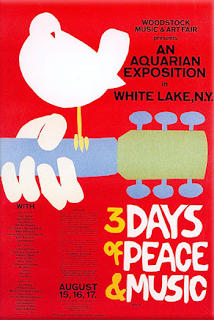“Woodstock then and now”. To its credit, Woodstock became a metaphor almost immediately. But Woodstock has always meant different things to different people – then and now.
In John Lawrence Ré’s DOMINOES a blistering music track guides us, without narration, through mesmerizing film footage of an explosive decade (1965-1975). DOMINOES is scheduled to be released on September 15, 2009. It can be pre-ordered starting August 18th, 2009, the day after Woodstock‘s 40th anniversary.
As Woodstock approaches middle age, I remember being fourteen and massive news coverage of 500,000 people descending on an Upstate New York dairy farm for a three day rock concert. Woodstock defined a radical turning point in American history. Revisiting Woodstock has made me realize…the more things change the more they remain the same.
By August of 1969 even strident military hawks saw things going astray in Vietnam. Embedded reporters gathered daily footage of dead American soldiers. Almost 50,000 American’s had been killed in this “military action” in Vietnam by the time the music started at Woodstock.
An unrepentant Nixon raged at anti-war protesters despite feeling the pressures of Vietnam. Just weeks before Woodstock, he issued his “Nixon Doctrine.” The South Vietnamese army was now responsible for tphysical fighting of the war; “Vietnamization.”
Nixon recoiled at the anger unleashed at him but resisted abandoning the “Domino Theory.” Control Communism in one place so neighboring countries would not fall. He fulminated at the audacity of the protesters but knew he had to counter a new alliance of anti-war groups. The Vietnam Moratorium Committee had massive national protests planned for October 15 of 1969. Nixon was proved right, as protests held that day gushed millions of people onto the streets, including masses of middle-class Americans.
Think tanks like The Hudson Institute bolstered Nixon and he began an effort to label the protesters as less masculine; unpatriotic. In the face of pervasive U.S. history to the contrary, Nixon attempted to castrate the anti war movement by condemning it for using a lawful option: peaceful protest.
Nixon proposed to divide the U.S. into two philosophically camps; one a dangerous pot smoking, draft dodging gaggle of young anarchists, lead by a noisy cadre of effete intellectuals, the other he would eventually term “The Silent Majority,” the largely war-backing, middle-class.
This necessitated that Nixon wage war on marijuana. By vilifying a drug that he could associate with the anti-war movement he could leverage national opinion against the protesters. Directives issued to law enforcement to pummel marijuana also included a softening of directives aimed at a drug that would become synonymous with the 70’s and beyond – cocaine. The think tanks advised Nixon on the cocaine for pot swap: marijuana made you think abstractly, cocaine physically. Heavy cocaine use leads to delusions of grandeur and identification with the ruling class — traits incompatible with rebellion and anarchy.
Testimony from convicted cocaine king pins have chronicled the rise of cocaine with this new federal policy. Cocaine soon become the most profitable industry on earth.
The cocaine connection to the Nixon White House was palpable as the notorious financial fugitive and drug smuggler Robert Vesco and Nixon’s best friend “Bebe” Rebozo often spent secluded time with Nixon on Rebozo’s boat at the Key Biscayne White House.
Nixon spokesmen’s predictions of anarchy at Woodstock proved futile. It not only became an unwitting testament to the power of protest – peaceful protest. Woodstock resulted in no violent deaths and only a smattering of drug arrests.
Woodstock emerged a tribute to the mood of the nation – PEACE NOW! It began the accelerated debate that continues today, as we attempt to emerge from wars in Iraq and Afghanistan, ponder Wall Street fraud, repair a badly battered economy and wrench health care debate from the clutches of lobbyists.
After the 40th anniversary will the important discussions remain within the confines of the internet or spill again onto Main Street given the new information age?
The only given (then and now) is that we are indeed living in interesting times.


